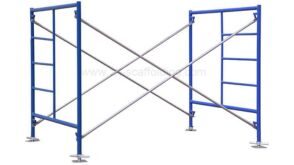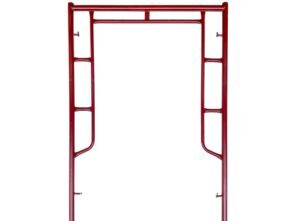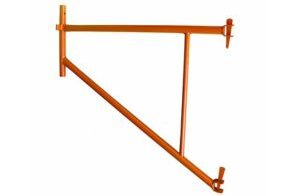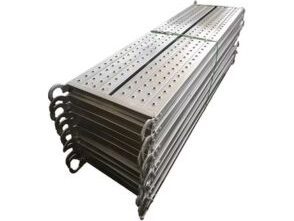Cantilever scaffolding, or needle scaffolding, is a type of scaffold that gets support only from one end whereas its other is extended out of the building. The primary support of the cantilever comes from the building or supporting structure against which it is erected. Scaffolds project outwards through strong anchoring systems, rigid frames, and beams secured into the building. Cantilever scaffolding is used when ground space is obstructed or inaccessible. It provides access to areas that are otherwise difficult to reach or access with traditional scaffolding.
The main types of cantilever scaffolding are single-frame, needle, double-frame, trussed, and counterbalanced cantilever scaffolding. The main benefits of cantilever scaffolding are accessibility, safety, space efficiency, versatility, and quick installation. The main uses of cantilever scaffolding are facade maintenance, building renovation, heritage preservation, window installation, and dam and reservoir maintenance.
Table of Contents
What is Cantilever Scaffolding?
Cantilever scaffolding is a temporary structure supported by cantilevered beams or needles that project horizontally from a structure or building. The best thing about the cantilever scaffold is that it doesn’t require any vertical supports on the ground. You can use a cantilever for urban areas or construction sites with limited ground space. It is useful in a construction project where contractors can not use traditional scaffolding. Cantilever scaffolding is a specialised scaffolding type, commonly used in areas with overhanging structures, narrow streets, and construction and maintenance projects.
Since cantilever scaffolds are ideal solutions for complex construction projects, they usually require precise planning. Besides, you need to hire expert laborers who can carefully assemble the whole structure. The structure must have a properly placed anchor and a well-balanced structure. Otherwise, it may lead to accidents.
Cantilever Scaffolding Images


What’s the Diagram of Cantilever Scaffolding?

What are the types of Cantilever Scaffolding?
The 8 types of cantilever scaffolds are as follows:
- Single frame type scaffolding
- Needle scaffolding
- Double-Frame Cantilever Scaffold
- Counterbalanced Cantilever scaffold
- Trussed Cantilever Scaffold
- Suspended Cantilever Scaffold
- Rolling Cantilever scaffold
- Joint Tower Scaffold

Single Frame Type Scaffolding: The single frame is secured to the structure of the building, and the extended frame of the cantilever beam provides a stable platform for workers to perform some easy tasks on the building. Workers can use this type of scaffolding to perform light tasks such as window installation and minor repairs to the building facade. It is considered most suitable for tasks where minimal scaffolding structure is required.

Needle Scaffolding: Needle scaffolding comprises a horizontal work platform or cantilever beam supported by needle beams resting on the building and structure under construction. This type of cantilever scaffolding is suitable for painting, plastering, and repair tasks. Whenever there is a restoration project for a historic building, a needle scaffolding structure is deemed suitable for this project. Because it requires minimal contact with the structure, project managers can complete the restoration tasks without affecting the structural integrity of historical spaces. Many contractors use needle scaffolding to install exterior fixtures such as lighting during home remodeling projects.

Double-Frame Cantilever Scaffold: A double-frame cantilever scaffold is designed with two frames combined into the building. This framework offers a high level of stability and heavy load-bearing capacity. It is helpful for essential tasks that need a large working platform. Construction tasks that involve multiple workers, heavier materials, and robust support require this type of cantilever scaffold. Since this structure supports multiple workers and equipment, thus it proves helpful for large-scale painting and cladding.

Counterbalanced Cantilever Scaffold: Counterbalanced cantilever scaffolding uses counterweights placed on the side of the cantilever framework to balance the load on either side. This framework is suitable for a building with limited space and when securing a scaffold to a building is impossible. You can use this temporary structure in areas with architectural restrictions. Workers can work on the exterior of high-rise buildings, especially when anchor installation isn’t feasible.

Trussed Cantilever Scaffold: Trussed uses diagonal bracing and truss-style structures to improve its load-bearing capacity and stability. This framework is practical for heavy-duty construction and maintenance activities. Its heavy-load capacity makes it an ideal temporary structure in industrial settings such as refineries and power plants. It offers a stable platform for workers under strenuous situations. Trussed cantilever scaffolding proves quite effective in areas prone to heavy winds and unstable conditions. You can also install this temporary structure during a large-scale construction project because it offers extensive horizontal reach from a single anchorage point.

Suspended Cantilever Scaffold: Suspended cantilever scaffold is suspended outward from overhead support. It allows workers to continue working on the exterior surface of buildings and at high-rise structures. It offers overhead support that workers can use to access high-rise buildings and difficult-to-reach areas. The best thing about this type of cantilever scaffold is that it doesn’t obstruct the space below and lets workers and pedestrians quickly walk around the construction site. A suspended structure proves effective whenever repair work needs to be done over waterways or busy roads. You can’t install a traditional scaffold on the ground base.

Rolling Cantilever Scaffold: Rolling cantilever scaffolding is placed on wheels and caster to improve its mobility factor. This type of cantilever scaffold has been proven effective for projects that require constant relocation, such as large-scale painting and maintenance work. It allows workers to access different sections of the building effortlessly. Since rolling scaffolds unlock a high level of mobility, you can use them for continuous tasks that you need to perform on pipelines and tunnels. You can make the most of the rolling scaffold whenever work areas need regular adjustment at large-scale manufacturing plants and shipyards. Since this structure moves quickly, workers can complete tasks immediately without downtime.

Joint Tower Scaffold: The join tower scaffold comprises multiple tower units connected with joint elements. Each metal-made tower has a horizontal platform at different levels. It allows workers to stand and work conveniently. This temporary structure is helpful for tasks where workers must safely work at various heights and vertical levels. Mainly, it is used to construct multi-story buildings and large-scale maintenance tasks. You can use this type of cantilever scaffold to set up large concerts and conferences. It is also effective in complex construction projects such as multi-rise buildings and malls because it offers flexibility.
What are the Techniques of Cantilever Scaffolding?
The five techniques of cantilever scaffolding are as follows:
- Horizontal Extension
- Needle Beams
- Counterweights
- Bracing
- Anchoring
1. Horizontal Extension
The horizontal extension technique is used when the base area can’t be erected. In that case, this extension lets the platform extend out away from the building or structure and get support from the beams and frames. A cantilever extends out from a secure base and lets workers access difficult-to-access areas.
2. Needle Beams
Needle beams are horizontal beams that provide support to the overall cantilever scaffolding structure. Holes are made in the walls, and needle beams are placed in these holes or secured around the column. These needle beams are the primary support for the system while distributing loads back to the main structure.
3. Counterweights
Counterweights are another technique used in cantilever scaffolding. They are placed on the opposite sides of the needle beams inside the structures. This counterweight protects the structure from tipping and balances the overall load. Counterweights are an essential technique to use with outward extension, as they maintain the equilibrium of the structure.
4. Bracing
Bracing consists of diagonal supports placed between standards and horizontal extensions. They boost the stability of the platform and distribute the load evenly. Braces are essential to prevent the structure from collapsing in windy conditions.
5. Anchoring
Anchoring is the most crucial technique used for cantilever scaffolding. The scaffold is attached to the building and structure securely through anchors, which prevent the structure from collapsing and moving. The stability of the structure heavily depends on the anchor integrity.
What are the Safety Requirements of Cantilever Scaffolding?
The fifteen safety requirements of cantilever scaffolding are as follows:
- Proper Load Distribution
- Professional Assembly
- Secure Anchoring
- Load Limits
- Regular Inspections
- Fall Protection
- Safety Training
- Adequate Bracing
- Guardrails and Toe Boards
- Plank Securement
- Clear Access
- Weather Considerations
- Proper Maintenance
- Personal Protective Equipment (PPE)
- Emergency Procedures
1. Proper Load Distribution: The weight on the platform must be distributed properly; otherwise, it may cause overloading and tipping. In this respect, the weight of materials, tools, and workers must be considered.
2. Professional Assembly: Another safety measure to consider is during the assembly of cantilever scaffolding. Only well-trained and qualified personnel should erect and dismantle this structure. As per OSHA standards, it must be erected or dismantled under the supervision of a competent man.
3. Secure Anchoring: The cantilever must have a safe anchor that attaches this temporary structure to a stable building. Make sure that you use properties and braces to anchor the structure.
4. Load Limits: Another safety measure to consider is the load limit. You must adhere to the maximum load capacity, as otherwise, accidents or structural failures will occur. As per OSHA Standards, Cantilever scaffolding must support its weight also about four times the maximum intended load without failing.
5. Regular Inspections: Regular inspection of the cantilever scaffold is a must, as it will help identify any signs of damage, wear, or tear. This inspection is a must after extreme weather conditions, such as heavy winds. A competent person must inspect the whole structure to ensure that it is safe to use.
6. Fall Protection: Workers must use proper fall protection equipment, such as safety harnesses; platforms are equipped with guardrails and toeboards, ensuring a safe and secure working environment.
7. Safety Training: Workers must undergo proper safety training to use cantilever scaffolds safely. They must also be fully trained to identify hazards, perform adequate fall protection, and follow emergency procedures.
8. Adequate Bracing: Ensure that proper bracing materials and techniques are used. Inspectors must regularly inspect bracings to identify any signs of wear and tear so that replacement can be done on time.
9. Guardrails and Toe Boards: Guardrails and toe boards are among the most important safety measures on Cantilever scaffolding, as they prevent fall accidents. Both guardrails and toe boards should be installed at the proper height.
10. Plank Securement: Planks must be secured on platforms to prevent shifting and dislodging. Proper plank securement methods, such as hooks, straps, and cleats, must be used. Planks must also be checked to ensure they are fully secured and adjustments can be made as needed.
11. Clear Access: Another safety measure while working on cantilever scaffolding is maintaining clear access to work areas and emergencies. Always keep work areas and walk away free from clutters tools, and debris. Your scaffold system should have proper lighting and signage for easy access and safe movement in all work areas.
12. Weather Considerations: The biggest safety requirement while working on a cantilever scaffold is assessing weather conditions. Look at the weather forecast and make a work plan according to it. Avoid working in extreme weather conditions such as high winds, rain, or snow. However, workers must use protective equipment and clothing if they have to do their jobs.
13. Proper Maintenance: There must be a proper maintenance schedule for every tool, equipment, or machinery so that if there is any damage or defect, it can be addressed immediately.
14. Personal Protective Equipment (PPE): Always provide appropriate Personal Protective Equipment (PPE) to workers based on specific hazards, such as gloves, foot and eye protection, hard hats, protective hearing devices, etc. You also need to train workers regarding the proper use of PPE.
15. Emergency Procedures: You must develop and implement proper emergency procedures for different scenarios, such as equipment failures, fires, injuries, etc. You can conduct regular drills to train workers to respond well in an emergency. In addition, you need to make sure that emergency equipment such as first aid kits and fire extinguishers are available on-site and easily accessible.
What are the Benefits of Cantilever Scaffolding?
The nine benefits of cantilever scaffolding are as follows:
- Flexibility
- Accessibility
- Safety
- Efficiency
- Versatility
- Space Efficiency
- Quick Installation and Dismantling
- Enhanced Visibility and Accessibility
- Cost-Effective Solution
1. Flexibility: Cantilever scaffolding is super flexible and can be adapted to different locations and building designs. This structure is quite suitable for situations where the base cannot directly support standards and where there are tons of obstacles on the ground.
2. Accessibility: Another plus point of cantilever scaffolding is that it provides easy access to areas that are otherwise difficult to access with traditional scaffolding.
3. Safety: A cantilever scaffold is highly safe because it is anchored directly into the building structure. Thus, it is more stable and safer than other scaffolding types. There is a low risk of collapse in this specific type of scaffolding. It’s because the structure is directly attached to the building. It is a safe temporary structure under diverse load conditions and heavy foot traffic.
4. Efficiency: Another plus point of cantilever scaffolding is that it boosts work efficiency. This scaffold structure is placed precisely where it needs to be. Workers don’t need to spend time climbing up and down; thus, their focus is maintained. Workers get direct access to the workplace. They don’t need to descend to the ground to access different levels of the buildings. It’s easy for them to continue working on their task without any interruption caused by the repositioning of the structure.
5. Versatility: Another benefit of cantilever scaffolding is its versatility. It is helpful for various applications, such as repairing high-rise buildings and renovating facades. The most significant challenges in urban areas are limited ground space and heavy foot traffic on public walkways and neighboring properties. In that situation, cantilever scaffolds proved to be a practical solution. It maximizes the use of vertical space without causing any ground disruption.
6. Space Efficiency: Cantilever scaffolding can be useful in areas where ground space is limited, such as tightly packed parks and crowded public spaces. It takes less space on the ground and provides more space for pedestrian paths and traffic.
7. Quick Installation and Dismantling: Cantilever scaffolding is super easy to install and dismantle as it has few components and uses only a single attachment point.
8. Enhanced Visibility and Accessibility: Cantilever scaffolding provides a better view and easy access to work areas. This enhanced visibility and accessibility allows workers to complete tasks quickly.
9. Cost-Effective Solution: The initial setup of cantilever scaffolding is complex and expensive, but it becomes cost-effective in cases where extensive groundwork can’t be done or scaffolding is impractical to install. Since this scaffolding is easy to set up and dismantle, it reduces labor costs and time.
What are the Disadvantages of Cantilever Scaffolding?
The six disadvantages of cantilever scaffolding are as follows:
- Complex Setup
- Higher Costs
- Limited Load Capacity
- Not Suitable for All Situations
- Safety Concerns
- Maintenance Requirements
1. Complex Setup
The biggest drawback of cantilever scaffolding is its complex setup. Only an expert with specialized knowledge of counterweights, needle beams, and anchors can handle its proper setup, as precision and careful planning are required during the procedure.
2. Higher Costs
You must incur high costs for the cantilever scaffolding as it requires unique components to build up. And you will hire skilled labor who can erect and dismantle the scaffold securely.
3. Limited Load Capacity
Cantilever scaffolding has a lower load capacity than traditional scaffolding. The structure has outward extensions that put pressure on the anchor and supporting structure. Whenever you use cantilever scaffolding, you need to stick with its load capacity and carefully consider the weight of materials, tools, and components that you put on this temporary structure.
4. Not Suitable for All Situations
Cantilever scaffolding is not suitable for buildings that can’t provide support to cantilevered loads and where structural support is insufficient.
5. Safety Concerns
Cantilever scaffolding requires proper setup. Safety risks increase If its structure isn’t built correctly. Another safety concern is improper load distribution. It extends outward from the building, and overloading on the cantilevered can cause excessive stress on the supporting structure, leading to bending, buckling, or complete structure failure.
6. Maintenance requirements
Cantilever scaffolding requires constant inspection and maintenance.
What are the uses of Cantilever Scaffolding?
Here are eight uses of the cantilever scaffolding:
- Façade Maintenance
- Bridge Construction
- Window Installation
- Building Renovation
- Industrial Maintenance
- Top Roof Maintenance
- Heritage Preservation
- Dam and Reservoir Maintenance
1. Façade Maintenance

Cantilever scaffolds are mainly used for facade maintenance. They are installed in the exterior areas of high-rise buildings so that workers can perform different tasks such as repair, cleaning, painting, and inspection.
2. Bridge Construction and Maintenance

A cantilever scaffold can be installed under the bridge to perform maintenance and inspection tasks. It is also used in the bridge construction process as it effortlessly offers access to the undersides, piers, and other structural elements of the bridge.
3. Window Installation and Replacement

Cantilevered scaffolds prove useful in buildings with limited ground-level access. This temporary structure allows workers to install or replace windows safely.
4. Building Renovation and Restoration

Cantilever scaffolds are also used in renovation and restoration activities. They provide easy access to historical buildings, churches, and other delicate facades.
5. Industrial Maintenance

Cantilever structure provides access to different industrial areas such as chimneys, pipelines, tanks, silos, etc. Workers can use this temporary platform to repair, inspect, and clean these areas.
6. Top Roof Maintenance

A cantilever scaffold platform allows crews to work on repairing, replacing, and inspecting rooftop structures with limited ground access.
7. Heritage Preservation

Traditional scaffolding can’t be used for restoring and preserving historic buildings, as it may damage the structure. In that scenario, project managers can rely on cantilever scaffolds.
8. Dam and Reservoir Maintenance

Cantilever scaffolds are used to repair, maintain, and inspect dams, spillways, and other water reservoirs.
What are the Parts of Cantilever Scaffolding?
The eight parts of the cantilever scaffolding are as follows:
- Main Frame
- Cantilever Beam
- Needle Beam
- Brackets
- Guardrails and Toeboards
- Platform Decking
- Ties and Anchors
- Counterweights
1.Main Frame:

The main frame is the primary structural part that offers foundational support. It is anchored to the building and provides support to the remaining parts of the scaffolds.
2. Cantilever Beam:

Cantilever beams are extended beams that project out from the mainframe and serve as a base for the platform deck. They are a crucial structure component as they distribute the load from the platform back to the supporting structure of the building.
3. Needle Beam:

Needle beams are inserted into the building through holes in the walls or around its features, like columns. They serve as a pivot point of the cantilever structure.
4. Brackets:

Brackets extend the working platform beyond the edges of the main frame. They are attached with cantilever beams or needles and hold the platform safely in place.
5. Guardrails and Toeboards:

They are safety parts of the cantilever scaffold. Guardrails are safety barriers installed on the platform’s edges to prevent fall incidents. Toeboards are placed on the guardrails’ base, preventing tools or other objects from falling from the platform’s edge form.
6. Platform Decking:

Platform decking is the stable working surface where workers stand and complete their tasks. It must be strong and stable so that it supports workers, tools, and materials.
7. Ties and Anchors:

Ties and anchors secure the scaffold structure to the supporting structure at different points. They tie the scaffold to the building, preventing it from swaying or collapsing due to heavy winds or overload.
8. Counterweights:

Counterweights are essential parts of a cantilever scaffold. They are placed on the opposite sites of the extension and balance the load of the scaffold, preventing it from tipping over.
What are Steps Involved in Erecting Cantilever Scaffolding?
The ten steps involved in erecting cantilever scaffolding are as follows:
- Site Preparation
- Assemble the Base Frame
- Install Vertical Frames
- Add Bracing
- Attach the Cantilever Beam
- Install Needle Beams
- Place Platform Decking
- Install Guardrails and Toeboards
- Secure Ties and Anchors
- Check Stability
1. Site Preparation
First, the site where scaffolding is erected must be prepared. This means cleaning debris from the area and checking that anchoring points and grounds are stable and strong enough to support this temporary structure. An expert will plan the proper layout of the structure so that it offers optimal access and efficient workspace.
2. Assemble the Base Frame
In the second step, the base frame, which is the foundation of the scaffold, must be assembled. It is usually anchored directly into the building structure.
3. Install Vertical Frames
Once the base frame is assembled correctly, the next thing to do is to install a vertical frame on the base frame with the help of secure fastening systems and locking pins. Systems.
4 .Add Bracing
Braces between vertical frames are added to increase the scaffold structure’s lateral stability and prevent swaying.
5. Attach the Cantilever Beam
Cantilever beams are directly attached to either vertical frames or the building. They extend outward to support the working platform. Make sure they are securely connected and can handle projected loads.
6. Install Needle Beams
Needle beams provide additional support to cantilever beams. They are installed into the walls or building structure through holes and serve as a stable pivot point for cantilever scaffolds.
7 .Place Platform Decking:
In this step, the decking is securely fastened to the beams, and the installer must check the platform for gaps or instability.
8. Install Guardrails and Toeboards:
Once a working platform is installed, expert labor will install safety features such as guardrails and toeboards around its perimeter.
9. Secure Ties and Anchors
Ties and anchors are placed at the scaffold’s strategic points to ensure that this temporary structure doesn’t shift or sway.
10. Check Stability:
It’s the last step in erecting cantilever scaffolding. An expert inspector will check the complete structure for stability and security. Check that all the components are tightly fastened and all the connections are proper. You must verify that the scaffold can safely bear the intended loads.






